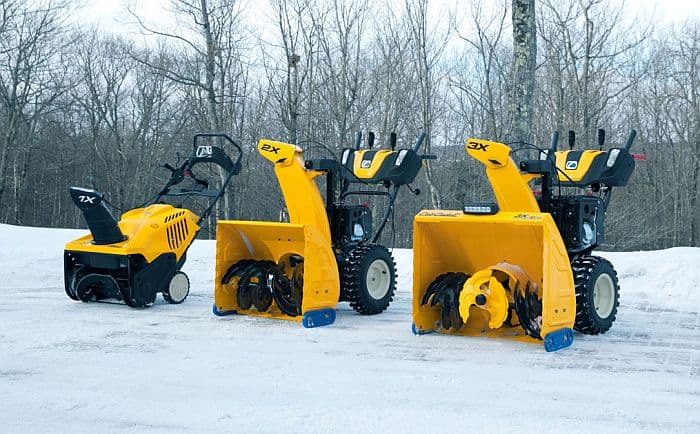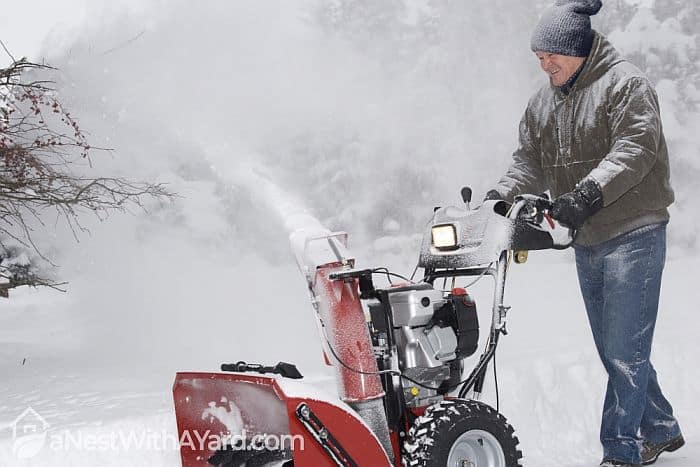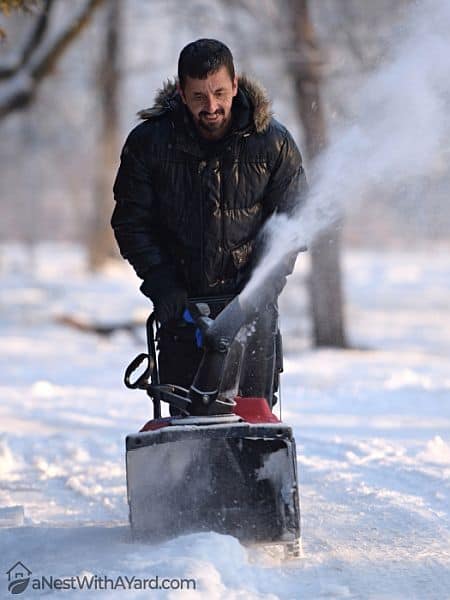When deciding what size snow blower would suit you best, check out the height of the ones you’re considering rather than their width as the height is the most limiting factor. The most common snow blowers on the market are the single-stage type and they’re generally around 18-22 inches wide.
If you’ve had enough of having to lug a big ol’ shovel around your yard after every snowfall, you might be thinking it’s time to get yourself a snow blower. But shopping for a snow blower is no easy feat, with all the different features and sizes to figure out.
If you’ve been asking yourself “What size snow blower do I need?” keep reading to find out everything you need to know about finding the perfectly sized snow blower for you!
Contents
Snow Blower Types

Before we jump into snow blower sizes, let’s do a quick recap of the types of snow blowers out there to help you narrow down your options.
There are 3 main types of snow blowers: single-stage, two-stage, and three-stage.
Understanding these types of snowblowers is crucial to figuring out which snow blower suits you best because these stages are indicative of how big or small they are.
What Does Snowblower Stages Mean?
Essentially, snow blower stages refer to how the snow blower feeds snow in and throws it out through its discharge chute.
Single-stage snow blowers have just one auger to feed the snow in and then throw it out, while two-stage snow blowers have two. Three-stage snow blowers have two augers, as well as an accelerator (which is the secret to how powerful they are).
So, the more parts the snow blower has, the bigger in size it is.
YouTube user Tools In Action does a great job of explaining the difference between each stage in this video:
Power Source

The three types of power sources needed to run snow blowers are battery, electric and gas.
Battery-powered snow blowers are lightweight and capable of clearing light amounts of snow. You’ll find that battery-powered snow blowers are only made in single stage.
Electric snow blowers are lightweight but slightly heavier compared to their battery-powered snow blower counterparts. These snow blowers are more powerful than battery-powered ones, but they’re also only made as single-stage blowers. They have limited snow removal capacity, but they work very well for residential use and in areas that don’t get heavy snowfall.
Electric snow blowers come in both corded and cordless varieties. You might find plenty of corded snow blowers, but the number of cordless snow blowers available on the market is quite limited.
One of the most highly recommended corded snow blowers on the market is the Snow Joe Electric Single Stage Snow Thrower. It has a 180° adjustable directional chute as well as compact wheels which make it easy to maneuver.
Corded snow blowers are best for smaller properties because they have to be plugged into an electrical socket. Cordless versions can be used on bigger properties, but they might not last very long until you need to recharge them.
A firm cordless favorite is the Snow Joe Cordless Snow Blower Kit, which comes with batteries and a charger. It can clear up to 14 tons of snow per charge and has an adjustable chut crank that can be rotated 180°.

Gas snow blowers are the heaviest of them all. They are more powerful than electric and battery-powered snow blowers, and they’re capable of clearing large amounts of snow.
This makes a gas snow blower more suited to cleaning snow from roads and for dealing with heavy snowfall, unlike electric snow blowers, which are best suited for residential properties and light to medium snowfall.
Gas snow blowers can be used for long durations without needing to be charged, but one of the biggest downsides to buying a gas-powered blower is that you’ll need to buy fuel regularly to keep it going. Handling and storing fuel comes with its risks, so extra caution needs to be applied.
Ariens Deluxe Two- Stage Electric Start Gas Snow Blower is a popular choice for many homeowners because of its ease of use and impeccable performance. This snow blower comes equipped with auto-turn steering technology and dual belt drive.
Check out this video by ExpertVillage Leaf Group for tips and tricks on how to maintain your gas-powered snow blower:
Amount Of Snow

To determine what size of snow blower is for you, you need to understand its snow holding capacity.
What’s snow holding capacity, you ask? A snow blower’s capacity to hold snow refers to the height of snow it can handle. Single-stage snow blowers are known to be able to handle 8-12 inches of snow, which is rather minimal, so these are more suitable for use in regions that receive light snowfall.
Two-stage snow blowers are more powerful and can clear larger areas and deeper snowfall. They’re typically used on roads and are capable of handling 10-18 inches of snow and work better on inclined surfaces.
Three-stage snow blowers can be best described as heavy-duty snow blowers. They can handle over 20 inches of snow and work excellently in snow belt areas that receive wet and heavy snowfall. If heavy snowfall is a challenge for you, a three-stage snow blower is definitely worth looking into.
If you have mostly wet snow in your area, read our post about the best snowblowers for wet snow.
Area Coverage

Another crucial factor you need to consider when determining the size of snow blower you need is how big of an area you have to cover. Here’s a general breakdown of the type of snow blower you should buy in relation to area size:
- Small yards: Single-stage snow blowers
- Medium-sized yards: Two-stage snow blowers
- Large properties: Three-stage snow blowers
Don’t forget to factor in how much annual snowfall your region receives. It’s also worth checking whether the snow blower you’ve set your sights on is compatible with the type of area you’ll be using it on. For example, is it a sloped surface? Or maybe it’s gravel-ridden?
For sloped surfaces, a self-propelled machine is your best bet. These are typically single-stage, which means they’re lightweight. They’re perfect because they’re easier to maneuver on sloped driveways and surfaces, as compared to heavier snow blowers.
If the area is covered in gravel, you need a heavy snow blower to withstand the rough surface. Two-stage and three-stage snow blowers are better equipped for this than single-stage snow blowers.
Check out this article with snow blower tips to help you make the process as fast (and pain-free!) as possible.
Intake Size

The size of your snow blower’s inlet plays a more important role in its performance than the size of the machine overall.
First, let’s look at inlet height. This will tell you how much snow your snow blower can suck up at once, in terms of depth of snow.
Next, we have the inlet width. This will help you figure out how many times you’ll need to go over a certain area in order to clear it. I wouldn’t say this figure is as important as your inlet height, but it’s good to cover all your bases, especially if the amount of time you spend snow blowing is important to you.
Engine Size

Single-stage snow blowers come with engines of around 200 ccs, two-stage with around 300 ccs, and three-stage with around 400 ccs of horsepower.
There’s one simple rule to understanding the size of snow blowers in relation to engine size: the more powerful the engine, the more efficiently it will perform and the less time it will take.
All set to hit the shops and get your perfect snow blower? Have a look at this piece for all the details on how snow blowers work to help you get started!
FAQs
How much snow do you need to use a snowblower?
To use a snowblower, some would say that you need snow that’s more than 2 inches deep for the best results. However, snow blowers work on pretty much any depth of snow, so there isn’t really a definite figure.
How much snow is too much for snowblower?
There is no limit to how much snow a snow blower can handle, but you need to consider how your snow blower will perform in heavy snow. If you have a snow blower that’s meant for light snow, it’ll take you much longer to clear heavy snow build-up.
What width snow blower do I need?
You need a snowblower that is at least 22 inches wide. A wide auger will reduce your snow blowing time. A snow blower with this width that is able to throw snow at least 60 inches is a favorable option.
Found Your Perfect Snow Blower Size?
Finding the perfect snow blower size for you takes some careful consideration of several important factors. Remember that the amount of snow you’ll be clearing and the features and performance of the snow blower are just as important as the snow blower size, if not more, and what you should try to focus on!
If you need a particularly easy to operate model, take a look at snow blowers for women and snow blowers for elderly.
Did you find this piece on snow blower size helpful? I hope I’ve been able to help you find the answer to “What size snow blower do I need?” Drop me a comment below, I’d love to hear from you!
Last update on 2024-04-26 at 03:53 / Affiliate links / Images from Amazon Product Advertising API


I’m afraid your research is a little flawed. There are 2 stage battery operated snowblowers.